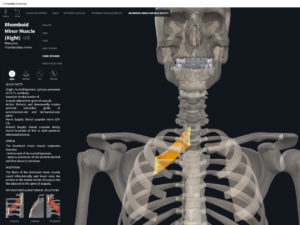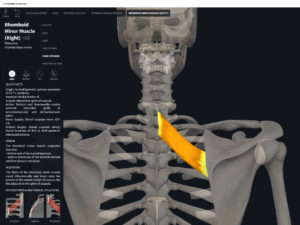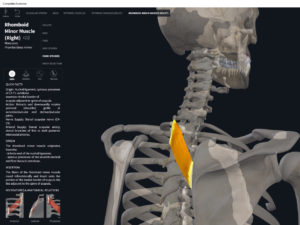Anatomy & Physiology: Muscles—Rhomboid Minor.
Structure.
- Origin: spinous process of C7-T1.
- Insertion: vertebral border of scapula superior to spine.
Function.
- Concentric action: scapular retraction and downward rotation. Medially tilts scapula at the scapulocostal joint (ScC).
- Reverse mover action: contralateral rotation of trunk at spinal joints.
- Eccentric action: controls/restrains/slows scapular protraction depression, upward rotation, and lateral tilt; controls/restrains/slows flexion and ipsilateral rotation of the trunk.
- Isometric action: stabilization of the scapula; stabilization of C7-T5 vertebrae.
- Innervation: dorsal scapular nerve.
- Arterial supply: dorsal scapular artery (branch of subclavian artery).
Clinical Significance.
References
Biel, A. (2015). Trail guide to the body: A hands-on guide to locating muscles, bones and more.
Cedars-Sinai. (2018). Vertebrae of the spine. Retrieved from https://www.cedars-sinai.org/health-library/diseases-and-conditions/v/vertebrae-of-the-spine.html
Clark, M., Lucett, S., Sutton, B. G., & National Academy of Sports Medicine. (2014). NASM essentials of corrective exercise training. Burlington, MA: Jones & Bartlett Learning.
Jenkins, G., & Tortora, G. J. (2012). Anatomy and Physiology: From Science to Life, 3rd Edition International Stu. John Wiley & Sons.
Muscolino, J. E. (2017). The muscular system manual: The skeletal muscles of the human body.



